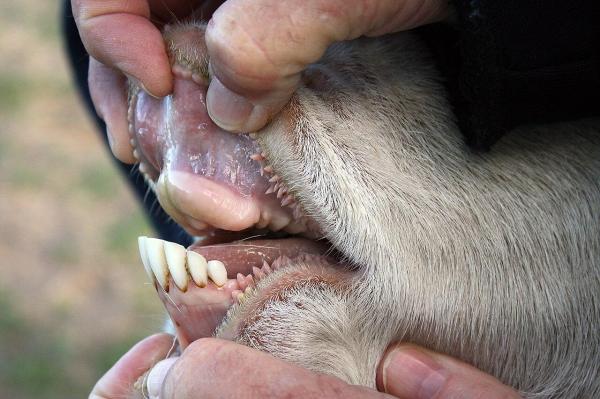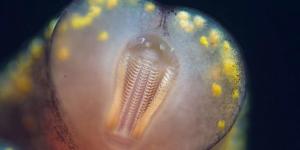Do Cows Have Teeth on the Top of Their Mouth?


Cows have 32 teeth which is the same number as certain other mammals, including human beings. However, the arrangement of their teeth is much different to our own. This is because cows do not have teeth as many in their upper jaw. Cows are ruminant animals, types of hoofed mammals that chew their food for a long period of time and have a specialized stomach to allow for digestion. These stomach are compartmentalized to allow for fermentation and other processes to break down the large amounts of roughage they consume. The cow's teeth are also specially adapted to help aid digestion by breaking down this fibrous material.
At thedailyECO, we discover more about cow dentition by asking do cows have teeth on the top of their mouth?
How many teeth does a cow have?
As stated in the introduction, an adult cow has 32 teeth in total. The dental formula for one side of the cow's jaw is as follows:
- Incisors: 0 above, and 4 below.
- Canines: 0 above and 0 below.
- Premolars: 3 above and 3 below.
- Molars: 3 above and 3 below.
Since the above cow dentition layout is only for one side of the cow's jaw, we need to multiply these numbers by two. This will give the complete set of cow teeth on both sides which amounts to 32 teeth.
Do cows have teeth on the top?
Cows are born with a set of teeth, called baby teeth. These will be replaced by permanent teeth when they grow up. This succession of teeth is known as diphyodontia. Only the incisors change, but the molars and premolars are always maintained, classifying the latter two type of teeth as monophyodonts.
When we look into a cow's mouth, it can appear as if they do not have any teeth in the upper jaw. While this is not the case, the confusion is understandable. Cows do not have front teeth on the top jaw. The lower 8 teeth can be visible when we look at a cow's mouth when chewing. These include the two middle teeth on the front lower jaw which are known as pincers.
Retracting the upper lip of the cow shows that there are no pincers or other teeth at the front. Instead there is a diastema, i.e. a gap between the nearest two teeth. This diastema is much larger than on most other animals, although it is not unique in the animal kingdom. The teeth are not missing. Instead, the gum is harder and thicker than in other parts of the mouth so that it can protect the jawbone underneath. This is known as a dental pad.
Learn more about the diet of animals like cattle with our article on what are ruminant animals?

Why do cows not have front teeth on the upper jaw?
The dental pad of a cow is where the incisors would normally appear on other animals, as they do in the lower jaw of cattle. This dental anatomy is a characteristic feature of ruminant animals. The absence of upper front teeth and the presence of a dental pad provide several benefits related to their diet, feeding habits and digestion. This means cows do not have front teeth in the upper jaw for the following reasons:
- Grasping and tearing grass: cows primarily consume a diet of fibrous plant material, such as grasses. Their lower incisors work together with their upper dental pad to grasp and tear grass. While they don't bite off chunks like animals with upper front teeth, their strong tongue and lower incisors help them pull and tear the grass effectively.
- Efficient mastication: cows are ruminant animals, meaning their stomachs have four compartments designed to break down tough plant fibers. The absence of upper front teeth allows cows to take large bites of vegetation without fully severing the plants. This is encourages the cows to chew their cud thoroughly during the regurgitation and re-chewing process, enhancing digestion by exposing the plant material to the cow's specialized stomach compartments.
- Grazing adaptation: cows are well adapted to grazing on grasses and other vegetation. Their unique dental anatomy suits their grazing behavior, allowing them to efficiently graze and process large amounts of fibrous plant material.
- Minimized tooth wear: the absence of upper front teeth reduces direct contact between the upper and lower teeth, resulting in less wear and tear on the dental structures. This can contribute to the longevity of the cow's teeth and reduce the need for continuous tooth replacement.
The absence of upper front teeth in cows is a specialized adaptation that aligns with their natural diet, grazing behavior and the specific digestive processes they've developed over time. It allows them to consume and process fibrous plant material efficiently, making them well-suited for their role as herbivores in various ecosystems.
What are cow teeth like?
Reviewing the formula of cow teeth we will notice several peculiarities. As explained above, this is due to the type of ruminant diet that cattle need for survival. For this reason, a cow's teeth have various characteristics:
- Since cows are ruminant animals that only consume plant matter, they have no need for canines (sometimes known as ‘fangs’). These teeth allow carnivorous animals to tear the flesh from their animal prey, something for which cattle have no need.
- Cows do have premolars and molars, using them process plant matter. Cows do not move their jaws up and down, but chew sideways to wear down and break down plant leaves. These fibrous plants include lignin which is quite hard and needs to be passed through the molars several times. To avoid wear, these teeth have very high crowns with many ridges.
- Teeth are a very important element used in livestock and veterinary science to determine the age of cows. This dental chronometry is possible because the determination of age is made with the incisors. We can even determine the breed of thanks to measuring the speed at which the incisor teeth appear.
Can cows bite?
Cows can potentially bite, but their biting behavior is not typically aggressive in the same way as predatory animals. Since they do not have upper incisors and their dental pad means they cannot close their mouth in the same way, cows only usually bite for the following reasons:
- Exploration and curiosity: cows use their mouths to explore objects in their environment. Without upper incisors, their biting behavior is often gentler than that of animals with sharp front teeth. Their dental pad doesn't allow them to deliver a true bite in the same way animals with upper incisors can.
- Playfulness: calves might engage in play behavior that involves mouthing or gentle nibbling. Their lack of upper incisors means that any nibbling is not as sharp or aggressive as biting with front teeth.
- Mimicking nursing behavior: calves might use their mouths to interact with their mothers during nursing, but this behavior doesn't involve biting in the conventional sense.
- Sensory exploration: cows use their mouths to explore textures and objects. Their dental pad allows them to grasp and manipulate objects, but their bites are not designed for aggressive actions.
- Feeding behavior: as explained above, the dentition of a cow is used to feed in a very specific way.
Cows are only aggressive if they feel threatened. They are quite shy animals and will not likely bite a human or another animal unless they are cornered. It is much more likely they will run away or charge if they feel very scared.

Other animals that do not have teeth on the top of their mouth
There are other animals that do not have teeth on their upper jaw. This is due to a dietary need similar to that of cows. These include other ruminant artiodactyls that also tear up plant matter and do not need the row of upper incisors. These animals include:
- Camels: they do not have incisors on the top jaw, but they do have two canines. They have 34 teeth in total and they use their canines to fight with other camels.
- Sheep: they do not have any upper front teeth, they only have 8 incisors below and very small and underdeveloped canines.
- Llamas: llamas also lack teeth on top, but their dentition is distinctive. They have molars and premolars in the upper and lower jaw, two small canines in the lower jaw and they only have incisors in the lower jaw. In the upper jaw they have a pair of incisors and another pair of canines modified into teeth to fight among themselves. They develop at 2-3 years in males and at 4-5 years in females. Domestic llamas usually have them removed for protection. Learn more with our article on the difference between llamas and alpacas.
- Giraffes: like cows, they have mostly molars and incisors on the bottom but not on the top. As with cows, giraffes are a type of even-toed ungulate animal.
- Chevrotain: also known as mouse deer, they are characterized by looking like a very small deer. Despite their name, they are neither a type of rodent, nor a type of deer. They have no upper front incisors, the lower canines look like incisors and they have very elongated upper canines protruding from the mouth.
Now we know all about the teeth of a cow, you may be interested in our related articles on whether turtles have teeth or whether frogs have teeth.

If you want to read similar articles to Do Cows Have Teeth on the Top of Their Mouth?, we recommend you visit our Facts about animals category.
- Cordero, L. & Salas, J. (1962) Diseases of Domestic Animals. Euned.
- Rouge, M. (n.d.). Dental anatomy of Llamas. VIVO Pathophysiology. Retrieved from: http://www.vivo.colostate.edu/hbooks/pathphys/digestion/pregastric/llamapage.html
- Meijaard, E. (2011) Family Tragulidae (Chevrotains ), in Handbook of the Mammals of the World. Volume 2. Hoofed Mammals (pp.320-335). Edition: 1stPublisher: Lynx EdicionsEditors: DE Wilson, RA Mittermeier.







